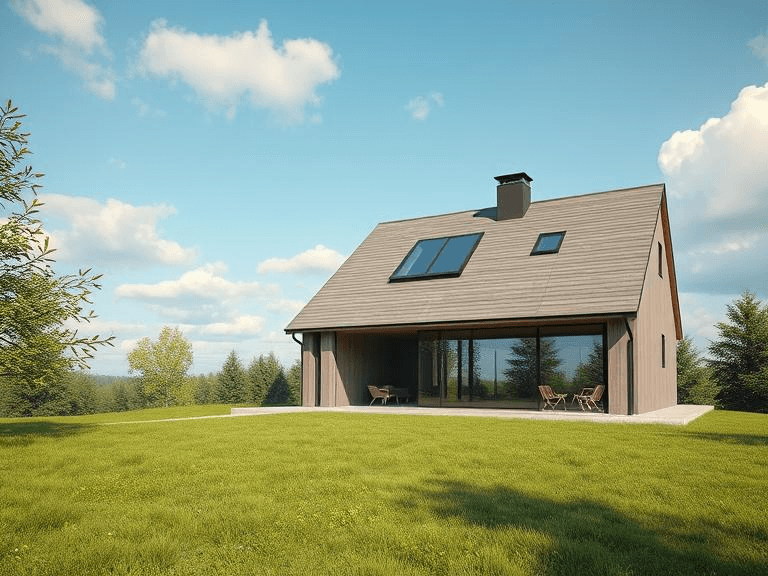
Eco-friendly roofing alternatives represent a significant shift in the construction and home improvement industries as society increasingly acknowledges the importance of sustainable living practices. These roofing options are designed to minimize environmental impact while providing functional benefits to homeowners. Defined as roofing systems that utilize environmentally friendly materials or processes, eco-friendly roofs contribute to energy efficiency, reduce waste, and often enhance the longevity of a structure.
The significance of eco-friendly roofing has grown profoundly in response to the escalating challenges posed by climate change and the urgent need for reduced carbon footprints. As energy consumption in homes accounts for a substantial portion of greenhouse gas emissions, selecting sustainable roofing alternatives can play a critical role in mitigating these effects. Homeowners are now presented with a range of options that not only align with their eco-conscious values but also offer practical advantages such as improved insulation and reduced energy costs.
Furthermore, the variety of eco-friendly roofing materials available caters to diverse aesthetic preferences and functional requirements. From green roofs that incorporate vegetation to reflective shingles that enhance energy efficiency, there exists a plethora of choices for those looking to make more sustainable building decisions. By opting for eco-friendly roofing solutions, individuals not only contribute to environmental conservation but also engage in practices that may increase their property’s value and comfort.
This overview sets the foundation for a deeper exploration into the various types of eco-friendly roofing alternatives. As we delve into the specifics of each option, it becomes clear that making informed choices in roofing not only benefits the environment but also enhances the overall quality of life for homeowners. The transition to sustainable roofing practices is essential for future generations, aligning our built environment with the principles of sustainability.
Popular Eco-Friendly Roofing Materials
Eco-friendly roofing alternatives have gained popularity as homeowners increasingly seek sustainable options that contribute to environmental conservation. Among the various materials available, metal roofing stands out for its durability and recyclability. Typically made from recycled materials, metal roofs can last over 50 years while reflecting heat, which can lead to lower energy costs. Their lightweight nature also reduces the structural load on homes, and when they reach the end of their lifecycle, they can be fully recycled, minimizing waste.
Clay tiles are another excellent choice known for their longevity and aesthetic appeal. They provide natural insulation and can withstand extreme weather conditions, making them suitable for a variety of climates. Clay tiles are sourced from natural materials, resulting in an environmentally friendly product. However, their heaviness requires proper structural support, which may elevate overall installation costs, impacting their affordability for some homeowners.
Slate roofing is prized for its elegant appearance and extended lifespan, often surpassing 100 years when properly maintained. Made from natural stone, slate offers excellent energy efficiency and fire resistance. The aesthetic richness of slate can significantly enhance property value, although its installation may be cost-prohibitive for many due to the high expense of both materials and labor. Furthermore, only sourced from sustainable quarries can slate roofing ensure minimal environmental impact.
Recycled shingles, made from reclaimed asphalt or fiberglass, present an eco-friendly roofing alternative that combines affordability with sustainability. They help divert waste from landfills while providing decent insulation properties. Nonetheless, their lifespan may be shorter compared to other materials, which could lead to more frequent replacements and maintenance.
Incorporating a range of eco-friendly roofing materials can help homeowners make informed decisions for their residences. Evaluating the benefits and potential drawbacks of each option enhances the ability to choose roofing solutions that align with sustainability goals while maintaining aesthetic and functional requirements.

Benefits of Eco-Friendly Roofing
Eco-friendly roofing alternatives offer a variety of benefits that appeal to both homeowners and the environment. One of the foremost advantages is the potential for significant energy savings. Many sustainable roofing materials, such as reflective shingles or green roofs, are designed to improve energy efficiency. By reducing heat absorption, these materials can lead to lower indoor temperatures, resulting in a decreased reliance on air conditioning during the warmer months. This reduction in energy consumption not only lowers utility bills but also minimizes the carbon footprint associated with energy production.
Another notable benefit of eco-friendly roofing is its positive impact on property value and marketability. Homes equipped with sustainable roofing options are often seen as more attractive to eco-conscious buyers. The increasing consumer interest in environmentally responsible practices means that homes that utilize eco-friendly materials can command higher resale prices and a quicker turnover on the market. Homeowners investing in these roofing alternatives are likely to benefit in the long run through enhanced property value.
In addition to cost savings and increased property value, there are often incentives available for homeowners who opt for eco-friendly products. Many local governments and utility companies offer tax credits, rebates, or other financial incentives for individuals who choose sustainable construction materials. These benefits can help offset initial costs associated with installing eco-friendly roofing systems, making them more accessible to a broader range of homeowners.
Adopting eco-friendly roofing not only aligns with individual homeowner values but also contributes to broader trends in green living. As society increasingly shifts towards sustainability, making conscious choices in roofing materials is an important step in reducing homeownership’s environmental impact. In conclusion, the benefits of eco-friendly roofing alternatives encompass energy savings, increased property value, and financial incentives, making them a sound investment for environmentally conscious homeowners.
Installation and Maintenance Considerations
When opting for eco-friendly roofing alternatives, it’s essential to consider both installation and maintenance aspects to ensure their longevity and effectiveness. Hiring experienced professionals who are well-versed in eco-friendly materials and installation practices is crucial. Such specialists understand the unique properties and installation requirements of various sustainable roofing options, whether it be metal, rubber, or reclaimed materials. Proper installation not only enhances the roof’s performance but also ensures that the eco-friendly features are fully realized.
Different eco-friendly roofing materials come with varying maintenance needs. For instance, green roofs, which support vegetation, require regular upkeep to ensure plants thrive and effectively manage stormwater. This can include watering, weeding, and periodic fertilization. Metal roofs, on the other hand, are known for their durability but may require occasional cleaning and inspection for rust or damage. Similarly, if you choose solar shingles as your roofing solution, it’s vital to have them checked regularly to ensure their efficiency and functionality.
Proper care of eco-friendly roofing not only helps extend its lifespan but also preserves its sustainable attributes. Regular inspections can help identify any potential issues before they turn into more significant problems, thus saving on repairs and reducing waste. It’s advisable to schedule maintenance at least twice a year, focusing on clearing debris and checking for any signs of wear and tear. By prioritizing both the installation by qualified experts and ongoing maintenance, homeowners can ensure that their eco-friendly roofing alternatives remain effective, visually appealing, and beneficial to the environment over time.


